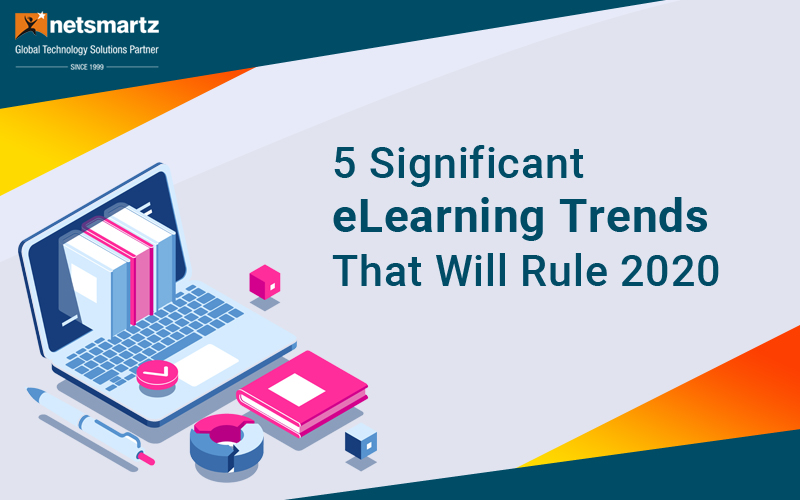When it comes to eLearning, the global market is growing at a very fast pace, and it will likely reach $398.15 billion by 2026, considering CAGR of 9.5%. Therefore, it is becoming necessary to understand market trends to stay ahead of the competition.
Therefore, it becomes necessary to understand the eLearning trends that will rule 2020 and how eLearning will be of huge demand crossing the corporate boundaries. Moreover, when you are an active eLearning enthusiast and gained years of experience with eLearning Consultancy Services, it becomes a mandate to bring out the significant trends that are likely to drive the industry in the future.
Let’s start with how the eLearning services industry would grow in 2020 and the coming years taking learning to greater possibilities.
eLearning as an LXP
The primary step that we are likely to see with eLearning after LMS (Learning Management System) would be a shift to the LXPs or Learning Experience Platforms. This time it will be oriented towards the idea of delivering self-directed learning aiming at all current and future industry trends. This would be more of a futuristic technology that will follow the visual capacity with most media websites and content streaming sources like YouTube.
Moreover, the giants of the eLearning industry have already started to shift their focus on LXP, such as LinkedIn Learning, where you can adopt video courses. This is a powerful example of eLearning that runs on LXP since it involves the potential use of AI-driven, panel-based learning. Also, existing LMS services have started working on LXP features, but it is a bit complex to align it with old LMS software.
However, modern LXP platforms are capable of mobile responsiveness as well as a social response based on AI technology. Simply, the future is all about self-driven eLearning solutions with LXP existing as a sole entity, unlike their current amalgamation with LMS.
Reporting with Learner Analytics
Learner analysis is a process to check the behavior of the student to work on the training process. eLearning services could choose from numerous tools for learning management to automated tutoring through systems, even those that support eye-tracking.
One thing which is very important to understand is that learner analytics develops information that does not require any advanced tools to translate. Therefore, it becomes easy to resolve all learning and development issues using LMS.
Most of the time, information required includes the rate of completion of courses, proactive learners, people who decided to learn, why they want to engage, strengths, weakness, and locating the best fit for tasks. One such example could be Joomla LMS, which offers amazing reporting features that can be tracked to define learning gaps, performance, and compliance.
Big Data & eLearning
Big Data in eLearning is purely the data collected from students, learning activities, and measurable performance. However, the huge quantity of this data takes longer to compile and process as compared to traditional databases. Therefore, big data analysis in eLearning helps to process the data and structure it for better presentation and interpretations.
Big data tools can help keep an eye on the growth structure of every student for developing a better learning environment. Plus, it can also help in uplifting ROI conversions based on useful information like the effectiveness of the learning process and productivity in students.
This information could be further used to adjust the existing learning strategies and creating more custom eLearning solutions. In short, big data analysis is a single tool that can help transform the learning process and make it more effective for the growth of students.
AI in eLearning
AI or artificial intelligence in eLearning could be extremely useful in training with the development of virtual teaching programs. AI learning could improve the scope of learning with multiple device support at any point in time.
Besides, the LMS model could be integrated with existing AI to teach students in a more personalized manner. This can help increase verbal communication where students could get solutions to their problems without browsing between thousands of results on the internet.
Also, AI can be used to design the route of learning for each student by analyzing past user data. The AI engagement model could also be made to work for students based on their intellect by redesigning the training modules depending on a student’s IQ. All in all, this can help leverage the training process at better speed, cost savings, and increasing effectiveness.
AR, MR, and VR
Most people love to watch videos and take in visual data, which means visual learning has serious advantages over reading. AR, VR, and MR are the visual technologies of the future that can create a deep learning experience for any student.
Currently, big brands like Boeing and Walmart are already investing in VR-based learning for their workers. This is evidence that the use of VR is shifting towards the education industry even though it is most associated with gaming.
Also, technologies like merged realities or MR can help anyone to have interactive learning as they are introduced to the real and virtual world at the same time. MR also has a greater scope of improvement and manipulation of the concepts.
The only reason which makes these options less feasible at present is the high cost. However, efforts from giants like Trivantis and Adobe could bring future VR, MR, and AR tools, which could help by reducing cost and the hassle of implementation.
The Crux
Overall, the concept of smarter and futuristic eLearning using technologies like big data analysis, AI, and VR are all part of a development model called the Learning Experience Platform. On the other hand, the implementation of all these tools and technologies could be the potential factor that will determine the success of eLearning’s future.
However, the precise and measured implementation of these technologies in eLearning solutions can completely transform the training and learning process and uplift the education and skill development industry.
struggling to find the right eLearning solution? Get personalized advice from our eLearning experts by connecting for a quick discussion today! Thank you!
Summary
Kickstart Your Project With Us!
Blog
Popular Posts
CONTACT US
Let's Build Your Agile Team.
Experience Netsmartz for 40 hours - No Cost, No Obligation.
Connect With Us Today!
Please fill out the form or send us an email to
 Don't Miss Out:
Don't Miss Out: 







